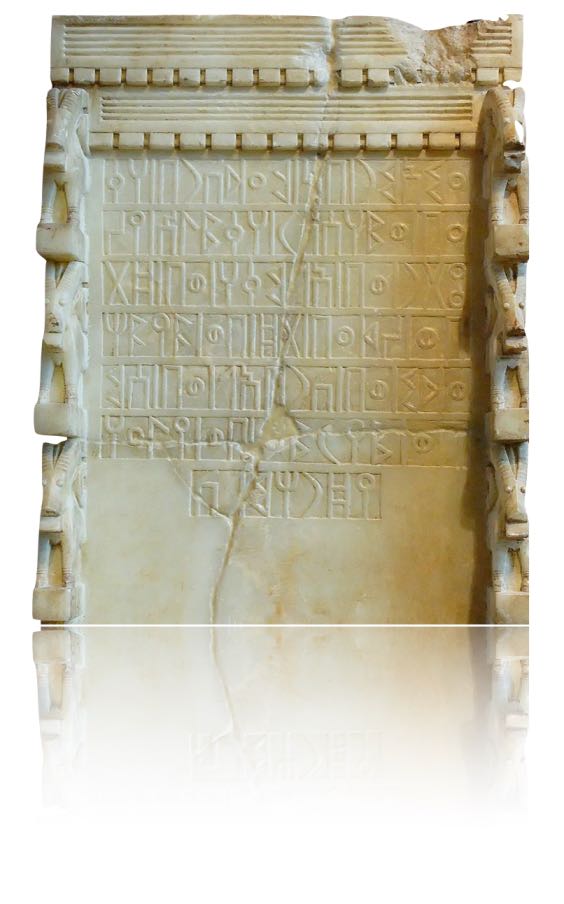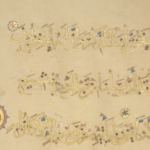
Hisham Adam penned an article on the Qur’ānic script in which he raised important points about the way the Qur’ān was written down, that is, the script used in the copy that we have in our hands now, known as ‘Uthmān’s Qur’ān’. All the points raised by Mr. Hisham deserve to be examined and the sources mined as to why the script appears in that form.
BY WAY OF INTRODUCTION Mr Hisham makes the following observation:
The Arabic language as spoken by the Bedouins of the Arabian Peninsula and parts of Yemen, Bahrain and northern Arabia is a written language, but the history of writing in Arabic has not been addressed in research and exploration, and therefore our sources on the origins of the Arabic language are well nigh scarce, with the exception of some books and investigations that deal with the history of Arabic. We cannot rely on those references that take Arabic to be a spoken tongue rather than written letters. But it is clear that it was almost identical to present day written Arabic (at least in the pre-Islamic era, specifically in the era of the expansion of trade in Makka with, of course, the absence of diacritic marks at that time)..
In fact, orientalist scholars in linguistics, history and archaeology have delved into the history of the Arabic language, especially over the last three or four decades of the 20th century. Everything they discovered so far shows that Arabic was a spoken language in the Arabian Peninsula, especially in the Hijaz, even though southern Yemen spoke Arabic and wrote it in musnad letters.[1]
Researchers have found numerous carvings dating back to the BC, era written in this musnad script, which consists of letters of the Arabic alphabet that are not dotted. Although Arabs from these regions migrated to the Hijaz and carried their religious beliefs with them, the Arabic language remained unwritten in the Hijaz and the rest of northern Arabia until the beginning of the fifth century AD. Before this time the Nabataean, Thamudic and Ṣafadic languages were the written languages for which researchers found evidence.[2]
They did not find any trace of the Arabic language
For example, researchers have demonstrated from all of the excavations carried out in southern Syria and in eighteen archaeological sites in the Kingdom of Jordan, that these were sites inhabited from the time of the Byzantine Empire up to the beginning of the ‘Abbāsid state. Although they found many Nabataean, Thamudic and Ṣafadic carvings and pottery, they did not find any trace of the Arabic language. Even in the Najaf desert in Palestine until the beginning of the Umayyad period all the sculptures and manuscripts found by researchers were written in Greek.[3] The oldest sculpture in Arabic, as far as we now to date, was found in the region of Ṭā’if in Saudi Arabia, and dates back to the 4th hijri era, that is, the middle of the seventh century AD. A sculpture written with Mu‘āwiya’s name is dated 58 AH / 678 AD. Mr. Hisham’s conclusion that Arabic was a written language is therefore not supported by known facts.
The conclusion reached by Mr. Hisham is based on his assumption that
this calls for recognizing the reserving of the written language for correspondence, commercial transactions, contracts and negotiations where the Quraysh were a party. We all know that the Arabs used writing for documenting contracts and agreements among themselves and there is no doubt that a standardised language (or spelling) was agreed upon for writing, just as the Quraysh language was the standard language at that time.
I am afraid I do not agree with Mr. Hisham on this assumption for several reasons. Firstly, writing among the Quraysh, as the Islamic heritage books tell us, was almost non-existent, Al-Ghazālī says in his work The Revival of the Religious Sciences:
Books and writings are recent things, none of these were in existence at the time of the Companions and the prominent Followers, they appeared after the year one hundred and twenty of the hijra and after all the Companions and most of the Followers had passed away, and following the deaths of Sa‘īd ibn al-Musayyib, Al-Ḥasan and the most prestigious of the Followers. The former deprecated the writing of hadiths and the authoring of books, deploring that people would thus occupy themselves with them instead of using their memory for the Qur’ān or spending time in contemplation. They said “Memorize things, just as we used to memorize them’”. Thus Abū Bakr and a group of Companions disapproved of writing down the Qur’ān in a codex saying: “How can we do anything that the Messenger of Allah himself did not do?” They were afraid lest people would rely on the Qur’ānic codexes, and said: “Let us leave the Qur’ān to be recited from one to another”. [4]
Al-Balāduhri also confirms this:
It is said that the first ones in Quraysh to learn how to write were Sufyān ibn Umayya ibn ‘Abd Shams and Abū Qays ibn Manān. From these Qīlān ibn Salama al-Thaqaf learnt it. When Islam emerged there were in all seventeen men in Quraysh who could write, as well as some women such as Al-Shifā’ bint ‘Abdullah al-‘Adawiyya, whom ‘Umar ibn al-Khaṭṭāb importuned to teach his daughter Ḥafṣa to read. [5]
Secondly, if the Quraysh could write, Muḥammad would not have had to exhort them in his Qur’ān from the Madīnan period to set down in writing what they owed:
When you deal with each other in contracting a debt for a fixed time, then write it down; and let a scribe write it down between you with fairness; and the scribe should not refuse to write as Allah has taught him [6]
Thirdly, the few treaties that were written down were written in Syriac, which was the language of culture, writing, and religion at the time. Al-Balādhurī also says the following:
‘Abbās ibn Hishām ibn Muḥammad ibn al-Sā’ib al-Kalbī told us what his father reported from his grandfather and from Al-Sharqī ibn al-Qatamī that: “Three people from Ṭay’ in Baqqa gathered together, these were Murr ibn Murra, Aslam ibn Sidra and ‘Āmir ibn Jadra, and determined the script by reconciling the Arabic spelling with the Syriac spelling. Some of the Anbār learned the spelling from them, and then the people of Ḥīra learned it from the people of Anbār. [7]
Even the Madīna treaty that Muslims claim Muḥammad signed with the Jews was not written down and no trace of it has been found. The first to mention it was Ibn Isḥāq, who died in 150 AH, about one hundred and forty years after the death of Muḥammad. Ibn Isḥāq did not mention any authority or the name of anyone who told him the text of that treaty, but nevertheless wrote down this treaty which he claimed was made between the Prophet of Islam and the Jews of Madīna.[8] Curiously, this version of the treaty mentioned by Ibn Isḥāq made no mention of the tribe of the Banū Qurayẓa or the tribe of Banū Qaynuqā‘ who were the largest Jewish tribes in Madīna. Most likely, there was no treaty in writing. It is thus clear that writing in Arabic was unknown in the fifth and sixth centuries AD.
Those who learned to write Arabic at that time wrote it in Syriac letters
After this simple introduction, we should move on to the heart of the matter – Qur’ānic script. Scholars agree that Aramaic is the mother tongue of all the Semitic languages. The Aramaic language gave birth to Syriac which was the language of the people of the Greater Syria. Following that was the Hebrew language, and most recently Arabic. Until the sixth century AD Arabic remained a spoken language only, especially in the desert regions in the north of the peninsula where the majority of Arabs dwelled. Those who learned to write Arabic at that time wrote it in Syriac letters, as mentioned by al-Balādhurī in the source above. The Qur’ān, therefore, was written in the Syriac script.
It is this that has led to some verses being misunderstood even by commentators, let alone the public. Al-Bukhārī narrates how the mother of Muḥammad tells how he remained silent when his Companions asked him about some verses that contained strange words. He also recounted how Sa‘īd ibn al-Musayyib,, one of the city’s seven scholars, fell silent as if he had not heard the question when someone asked him about a strange word, or how he used to say “Do not ask me, but ask someone who says that ‘some of it is no longer hidden from him’, and by this he meant Ikrima.

Suggested Reading
Because the commentators were ignorant of the Syriac language, they resorted to lying and inventing interpretations that had nothing to do with the truth. For example, when they came to interpret the verse:
What is then the matter with them, that they turn away from the admonition, as if they were asses taking fright and fleeing from a lion [qaswara]?[9]
They said that qaswara means ‘lion’ in the Abyssinian language, as al-Ṭabarī narrated from Ibn ‘Abbās. But when the German orientalist Christophe Luxenberg consulted the Ethiopian dictionary, he could not find the word qaswara in it.
In Syriac, however, the word means a donkey that is old and cannot carry anything. So the correct sense therefore is: ‘Why then should wild asses flee from an old donkey?’
[1] The South Arabian script, known as musnad, was an ancient form of writing that branched from the Proto-Sinaitic script in about the late 2nd millennium BC. It was used for writing the Old South Arabian languages Sabaean, Qatabanic, Hadramautic, Minaean and Hasidic and the Ethiopic language Ge’ez, and remained in use until the 6th century AD when it was displaced by the Arabic alphabet. (Ed.)
[2] Yehuda Nevo & Judith Koren, Crossroads to Islam, p. 176.
[3] Op. cit.., pp. 92, 174.
[4] Al-Ghazālī, The Revival of the Religious Sciences, Chapter on Worship, p. 51.
[5] Al-Balādhurī, Futūḥ Al-Buldān, p. 531.
[6] Qur’ān II (al-Baqara), 283.
[7] Al-Balādhurī, Futūḥ Al-Buldān, p.233.
[8] R Stephen Humphreys, Islamic History, p. 92.
[9] Qur’ān LXXIV (al-Mudaththir), 49-51. On this, see C. Luxenberg, The Syro-Aramaic Reading of the Koran : A contribution to the decoding of the language of the Koran, pp.60-63. For this work see the Almuslih library, listed under the rubric: The Qur’ānic Vorlage thesis. (Ed.)

